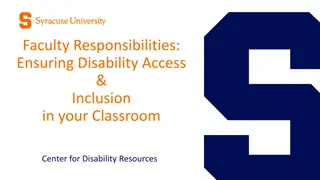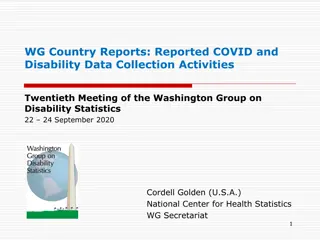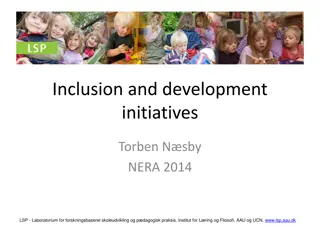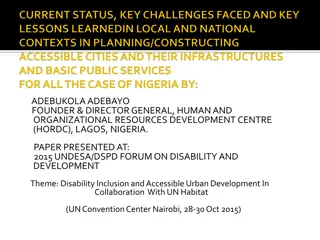Disability Inclusion Checklist for School Leaders
This checklist guides school leaders on implementing Disability Inclusion activities annually. Covers policy, funding, professional learning, IEPs, SSG processes, community engagement, and resource allocation.
Download Presentation

Please find below an Image/Link to download the presentation.
The content on the website is provided AS IS for your information and personal use only. It may not be sold, licensed, or shared on other websites without obtaining consent from the author. Download presentation by click this link. If you encounter any issues during the download, it is possible that the publisher has removed the file from their server.
E N D
Presentation Transcript
DISABILITY INCLUSION - CHECKLIST FOR PRINCIPALS AND LEADERSHIP TEAMS This checklist outlines potential Disability Inclusion (DI) implementation activities for each year of the reform s rollout in your school. As DI is a transformational change, responsibility for the below activities are best suited to the principal or one of the school's leadership team with experience in supporting culture change - such as an Assistant Principal or DI Lead with a leading teacher or learning specialist role. YEAR PRIOR TO COMMENCEMENT Stages Activities Resource/Information Attend Dl information sessions to develop an understanding of the key components of the reform School leaders will be invited to information sessions, run in the year prior to roll-out via Area Executive Directors DI 101 sessions are available to school staff to access through - Arc | Events Familiarise yourself with the guidance in the Policy Advisory Library (PAL) and associated resources. PAL guidance: Disability Inclusion Profile PAL guidance: Disability Inclusion Funding and Support Encourage staff to undertake (free) professional learning including DI, Individual Education Plans (IEP) and Nationally Consistent Collection of Data on School Students with Disability (NCCD) eLearning modules. eLearning modules (visit eduPay, click MyLearnEd and search Disability Inclusion and NCCD ) Disability Standards in Education Professional Learning Foundational information and knowledge building Ensure staff have access to Professional Learning opportunities in Inclusive Practices VDEI Professional Learning Catalogue Master of Inclusive Education Program Graduate Certificate in Education (Learning Difficulties) program Build awareness and capability within your school of IEP using universally available professional learning supports and resources. PAL Guidance: Individual Education Plans (IEPs) IEP eLearn module (visit eduPay, click MyLearnEd and search Individual Education Plans ) IEP Quality Checklist Rubric (PDF) Review Student Support Group (SSG) processes PAL guidance: Student Support Group (SSG) Engage Regional and Area based staff to discuss readiness for DI See further support on next page for contact details of DI regional implementation teams. Communicate the reform to your school community Communications and engagement tools 1
YEAR PRIOR TO COMMENCEMENT (cont.) Stages Activities Resource/Information Use available data to identify students who require additional support beyond Tier 1, to access and participate in education PAL guidance - Target group for Tier 2 school-level support eLearning module 6: Tiered funding and support model (visit eduPay, click MyLearnEd and search Disability Inclusion ) Consider available funding to support identified student needs e.g. Tier 2 funding alongside other funding sources such as Equity Funding and the Schools Mental Health Fund. PAL guidance - Student Resource Package Equity Funding (Student-Based Funding) PAL guidance - Mental Health Fund and Menu In Term 4, incorporate whole-school inclusion as a focus in your school s Annual Implementation Plan (AIP) through: PAL guidance - Disability Inclusion Funding and Support: Planning for expenditure Planning for Tier 2 expenditure evaluating current inclusion practices and their impact on student outcomes PAL guidance - Disability Inclusion Funding and Support: Resources prioritising areas for improved inclusion practices in the following year PAL guidance - Disability Inclusion Tier 2 resource for schools (PPTX) developing a plan to improve these practices, including the specific activities that will be undertaken, and plan for the use of Tier 2 funding in the SPOT funding planner. PAL guidance - AIP Evaluation and Diagnose guidance PAL guidance - AIP Develop and Plan guidance Consider staffing requirements to implement DI activities, e.g. a DI leader/coordinator, allied health staff, support staff. Consider scheduling a Practice Profile Session with the Disability Inclusion Facilitator Service. PAL guidance - DI leader/coordinator position description (DOCX) Disability Inclusion Facilitator Service Review existing systems, processes and documentation used to plan, implement and monitor adjustments (e.g. use and storage of IEPs, SSG Minutes, Planning documents). PAL guidance - Supporting information required for the Disability Inclusion Profile Preparing for Profiles PAL guidance - Supporting Information Guidance for Schools (DOCX) Consider a transition plan for moving your students to DI See suggested approach for the first, second and third years below. See Suggested School Transition Schedule diagram on slide 5. 2
FIRST YEAR Stages Action required Resource/Information PAL guidance - Individual Education Plans (IEPs): Policy Commence DI profiles for students with a focus on target cohorts: New students (e.g. prep students, year 7 students, students new to the system). Students with Program for Students with Disabilities (PSD) funding due for review that year (i.e. 6/7 Review* and Short Term Funded). Students who are not currently funded by PSD but for whom substantial and extensive adjustments are being made. *: Students in Year 6 will continue to be supported by the PSD and will complete the DI profile at their secondary setting in Year 7. PAL guidance - Student Support Groups: Policy PAL guidance - Supporting information guidance for schools (DOCX) Prioritising Profiles Implement and monitor planned DI activities as outlined in your AIP and guided by Framework for Improving Student Outcomes (FISO 2.0). PAL guidance - Annual Implementation Plan (AIP): Stage 4: Implement and monitor Reflect on progress and review the funding planner in SPOT through the mid-year monitoring process. PAL guidance - Framework for Improving Student Outcomes (FISO 2.0): Policy Implementing Tier 2 including building staff capability. Reflect on the year s planned AIP activities, expenditure and impact on student outcomes through the end-of-year assessment process. Encourage Business Managers to familiarise themselves with the expenditure reporting policy and report DI Tier 2 expenditure monthly or at point of expenditure Disability Inclusion eLearning module 7: Requirements for Reporting of Tier 2 School-Level Expenditure (search Disability Inclusion in LearnED). PAL guidance - Requirements for reporting of Tier 2 expenditure Encourage staff to engage in network or area-based DI Communities of Practice Speak with Health and Wellbeing Key Contacts, Regional Disability Coordinators and Senior Education Improvement Leaders (SEILs). 3
SECOND YEAR AND THIRD YEAR Stages Action required Continue to undertake profiles for students commencing with target cohorts Prioritising Profiles Undertake profiles for other students not captured as a target cohort (e.g. current students with PSD funding not set for review within timeframe, current students without PSD who would benefit from a profile). Each year, use reflections and student outcomes data from the previous years AIP to inform future planning. Develop your school s next steps in building whole school approaches to inclusion and lifting capability to respond to students with disability. Implementing Tier 2 Continue documenting planned activities and expenditure through the AIP in SPOT. Continue reporting Tier 2 expenditure in eduPay and CASES21. Further support Seek further support and information by contacting your Disability Inclusion Regional Implementation Team: North Eastern Victoria Region - nevr.disability.inclusion@education.vic.gov.au North Western Victoria Region - nwvr.disability.inclusion@education.vic.gov.au South Eastern Victoria Region - SEVR.Disability.Inclusion@education.vic.gov.au South Western Victoria Region - SWVR.Disability.Inclusion@education.vic.gov.au 4
Disability Inclusion Suggested School Transition Schedule summary Reach out to your Regional Implementation Team (RIT) if you need support at any time Second year First year Third year Concentrate on completing only the target cohorts including: New students: Prep students, Year 7 students, students new to the system. Students not currently funded by PSD but for whom substantial and extensive adjustments are being made. Students with individualised disability funding who are due for review Continue with target cohorts and remaining identified groups Continue with target cohorts and other students not captured as a priority cohort: current students with PSD funding who are not due for review this year, current students without PSD who would benefit from a profile. Consider how Tier 2 funding can support your school to plan and implement evidence-based, inclusive education for all students. Refer to the allowable uses, and examples of activities and adjustments on PAL. 5




































